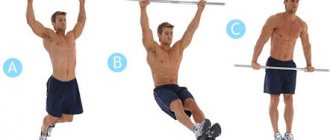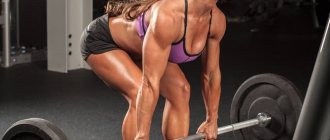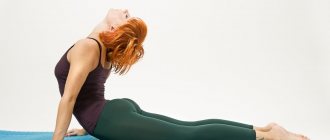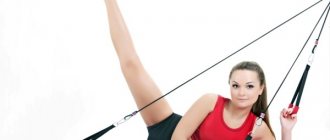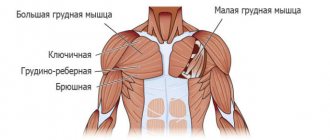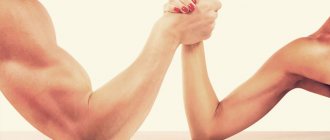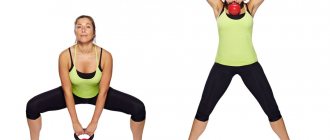06/08/2021 | Category Osteochondrosis
There are different organs in the body - heart, liver, lungs, spleen, intestines, brain, etc. The muscular organ is the “king” for all the others. And all because most of the body consists of it. Some muscles contract consciously, some unconsciously, such as the heart. The muscular organ has its center, which is located in the spine. And when a person has pain in the very core of this organ, which is called the deep muscles of the spine, for some reason he often treats this quite calmly and does not take any action. If the heart hurts, a person begins to actively treat it and does not wait until a heart attack occurs. The same goes for headaches and liver discomfort.
Chronic pain in the back and sides is a very important and serious symptom that many people neglect. After all, a person cannot live without a muscular organ. He will not be able to move, eat, or breathe. Without it, it will be impossible to perform the simplest functions. It is as vital an organ as the brain. If you have back pain in the spine area, you don’t need to endure it. It is necessary to start treating it, and not suppress yourself with non-steroidal, anti-inflammatory drugs.
Causes of back pain
Back pain is usually caused by spasms that occur due to dysfunction of the extrinsic muscles. For example, leg muscles have weakened due to physical inactivity. Then the lower back weakens, and subsequent problems begin to develop. Back pain can occur for the following reasons:
- inflammatory processes in tissues near the spinal column;
- spinal injuries;
- pinching of the nerve roots between the vertebrae;
- excess lactic acid in the muscles, which occurs with frequent, heavy loads on the body.
Sometimes the causes of back pain can be due to unhealthy lifestyle factors:
- sedentary work, physical inactivity;
- lack of sports activities;
- frequent overeating and, as a result, high body weight;
- excessive physical activity, which puts a lot of stress on the joints and spine.
It is important to remember that back pain is not a disease, but a symptom of one of the diseases. If you feel discomfort in your back, your arms go numb, your cartilage crunches when you move, then you need to conduct a diagnosis and identify the true cause of these symptoms. It is advisable to do this as soon as possible, since the success of treatment is influenced by how quickly you see a doctor and begin to perform therapeutic actions.
Safety rules for performing back exercises
- Perform back exercises in the gym only if there are no contraindications from a doctor (serious illnesses, injuries).
- Back training in the gym must begin with a warm-up.
- Follow the technique (it is better if an experienced trainer shows you all the exercises).
- Increase the load gradually.
- Avoid sudden movements.
- At the first sign of discomfort or pain, stop performing back exercises in the gym and consult a doctor.
Diagnostics
If you feel pain from your back, you shouldn’t endure it and wait for it to go away on its own. You need to see a doctor who will examine you and conduct a diagnosis. It includes listening to the patient’s complaints, examination by a neurologist, orthopedist and traumatologist. After all this, you may be prescribed blood and urine tests. In some cases, it is recommended to take an X-ray if you have previously suffered a back injury. Diagnostics are carried out using modern devices - ultrasound examination, magnetic resonance imaging, computed tomography. Diagnosis is recommended even after you have completed a course of treatment. This should be done for prevention purposes.
Complete back workout
Elliptical training
- 5 minutes
- Body part: Quadriceps Equipment: Exercise
Dynamic stretching of the back muscles
- 1 set of 20 reps
- Body Part: Lat Equipment: No
Stretch “Kitty”
- 1 set of 20 reps
- Body Part: Lower Back Equipment: No
Stretching while lying down
- 1 set of 20 reps
- Body Part: Lower Back Equipment: No
Stretching while sitting
- 1 set of 20 reps
- Body Part: Lower Back Equipment: No
Throwing a medicine ball to the floor
- 1 set of 20 reps
- Body Part: Lat Equipment: Medicine Ball
Standing lateral raises with dumbbells
- 1 set of 20 reps
- Body part: Shoulders Equipment: Dumbbells
Reverse ring pull-ups
- 1 set of 20 reps
- Body Part: Middle Back Equipment: Other
Pull-ups with expander
- 1 set of 10 reps
- Body Part: Lat Equipment: Other
Add to Calendar * Add to My Workouts * Print Workout
* — The service is in beta testing
What happens if back pain is left untreated?
Back pain, which has developed into chronic pain, begins to affect the condition of the entire body. If you tolerate it and do nothing, the blood flow to the brain is disrupted, because the vertebral artery, which supplies the brain, passes through the neck. After all, pain will sooner or later produce a spasm that disrupts the nutrition of cartilage and intervertebral discs. You will end up with brain problems.
What happens next? The nerves in the cervical region, from which the arms extend, are pinched. Pain and numbness begins in the hands. The nerves that regulate the activity of the diaphragm are also pinched - breathing function is impaired.
A nerve plexus is formed in the thoracic region, which regulates cardiovascular activity. When the nerve in this area is pinched, interruptions in the functioning of the heart begin. Intestinal functions are disrupted, chronic diseases of the gastrointestinal tract and liver occur. The kidneys, bladder, and gonads of the pelvic organs begin to work poorly. Sexual dysfunction occurs. Unfortunately, many go to treat these very problems, not even suspecting that the root cause is a sore back. The result is a vicious circle, and the person does not know what to do. Just remember that a healthy back is key to your overall well-being. And many diseases are associated precisely with dysfunction of the vertebrae, muscle tension and nerve endings.
What exercises can be done at home to cure scoliosis?
As we have already said, what exercises are selected for you will be determined by:
- degree of curvature of the spine;
- general condition of the patient;
- the state of specific organ systems, etc.
As a result, the disease can only be cured on an individual basis. Therefore, all the exercises that we will present below are given to you for reference, or can be used by you provided that they were prescribed by a doctor, but the patient has forgotten the correct technique for performing them. Remember: health is not a toy, and by mindlessly self-medicating, you may not cure the disease, but contribute to its further progress.
Step No. 1 – warm-up: taking the desired position
So, first of all, we need to do a warm-up. It is needed to warm up the body and prepare it for the lesson. All professional bodybuilders know that if you don't warm up before training, you can get injured. And if it seems to you that less intense loads do not require warm-up, then this is wrong.
Imagine that our muscles and ligaments are hardened rubber bands. If you pull them too hard, they may burst and become unusable. But if you preheat them, they will stretch as they should. Of course, the tissues of the human body are capable of regenerating, however, patients with scoliosis do not have the time and sufficient health to conduct such experiments on themselves.
So, when doing exercises to combat scoliosis, you should begin the warm-up by straightening your back in an upright position. This is done as follows:
- select a vertical, flat surface (for example, a wall);
- turn your back to her and move close so that the walls touch yours: shoulder blades, gluteal area, calves;
- stand in this position for a while to get used to it, and then, maintaining the position, take two steps forward.
In this physiological position we will perform further exercises.
Step No. 2 – warm-up: exercises
Having assumed the correct position, we begin to perform the exercises.
1. Straighten your back, spread your legs so that they are exactly under your shoulders. Then direct both your hands:
- up;
- then to the side and a little back.
This warm-up exercise is repeated 4 times.
2. Once again take the starting position while standing. Bring your legs tightly together, and place your hands on your waist. Now:
- start bending your knees one at a time, without lifting them too high;
- then sit down, also shallowly.
This exercise must be repeated at least 3 times.
3. Stand up straight again. Begin to imitate walking, staying in one place without raising your legs too high. At the same time, control your breathing:
- inhale, counting “1, 2” to yourself, while raising your arms across your sides to the ceiling;
- at “3, 4″, exhale, returning the limbs to their original position.
This warm-up will take you a very short amount of time.
Step No. 3 – performing basic exercises
Let's move on to the basic exercises.
1. Lie on the floor (preferably on a mat or carpet) and place your hands behind your head. Next, we will perform the movements and breathe in unison:
- inhaling, we spread our elbows to the sides;
- exhaling, we return to the starting position.
This exercise is repeated 5 times.
2. Stay on the floor after performing the previous exercise. Start bending your legs, pulling them towards your stomach:
- right first;
- then left;
- then with both feet.
This exercise is repeated 4 times. One circle (left + right + both) – one repetition.
3. Roll over onto your stomach and place your arms on the sides of your body, with your palms on the floor. Further:
- inhale, rest your palms, and lift your right leg as high as possible, then return to the starting position;
- repeat the same for the left leg.
This complex is repeated from start to finish at least three times.
4. Roll over and lie on your back again. The arms need to be pulled up again, this time along the head. Let's do passive traction, starting with inhalation:
- pull your arms and shoulders up;
- legs and hips down.
5. Return to your stomach. Start imitating the movements you perform when swimming with breaststroke, arms and legs at the same time.
Step #4 – Cool down
The cool down is simple and quick.
1. Get up from the floor and stand straight. Place your hands on your waist. Start walking in place again, only this time:
- inhaling, raise your arms from your waist up;
- simultaneously with raising your arms, begin to step not on your entire foot, but on your toes;
- after your hands drop, you will need to step on your heels.
2. Continue walking in place, raising your knees high up.
So, our lesson in therapeutic physical education aimed at combating scoliosis is over. We hope you have learned useful exercises for yourself, or figured out how to do the exercises prescribed to you by your doctor.
Treatment for back pain
There is no need to suppress pain with pills. They can only alleviate the condition for a while, but will not cure the essence itself. Constant use of the drug will negatively affect the condition of internal organs, cause a number of side effects, and then you will have to treat a whole bunch of other diseases. Dr. Shishonin believes that back pain should be treated without medications. After a correctly established diagnosis, certain treatment methods are prescribed:
Treatment for early back pain is quite simple. It covers conservative therapy methods: gymnastics, exercise equipment, massage, etc. In the process of performing exercises, the superficial and deep muscles of the back are strengthened, and the body's endurance to various loads increases. In order not to bring the body to a critical state, when without surgery a person faces disability, it is necessary to react to minimal symptoms and immediately take care of your health.
Physiotherapy
In order for the back muscles to always be in good shape, not to relax, not to stagnate, you need to devote a little time to them every day. To do this, it is recommended to perform therapeutic exercises, which will strengthen the muscles, remove excess stress from them, relax and eliminate spasms.
After all, pain in the spine deprives you of joy, depresses you, immobilizes you. A person cannot perform his work to his full potential and is constantly distracted by unpleasant sensations. About 1/3 of the entire population of the planet suffers from back pain. Unfortunately, this figure only increases every year. But if you do the right exercises every day, even a sedentary lifestyle will not harm your health.
There are three effective and simple exercises that you can do at home. They take a minimum of time, but the benefits from them are enormous.
Child's pose
You need to kneel down, then bend your legs and lower your pelvis, sitting on your heels. Afterwards, you need to spread your knees and bend towards the floor, stretching your whole body. The head should be lowered and the arms should be stretched forward with a slight stretch. Never bend your arms, they should be straight. The pelvis should be pressed against the heels. At the same time, the back becomes rounded, the neck vertebrae also arch.
You need to stay in this position for 30 seconds, after which you slowly and carefully return to the original position. If pain is felt in the back area, the exercise should be stopped.
The exercise is used to relieve tension in the back muscles, completely relax it, stretch the vertebrae and remove tension. At the same time, the pressure on the intervertebral discs weakens. As a result, the painful sensations recede.
"Kitty"
To perform this exercise, you will need to get on all fours. At the moment of exhalation, stretch your shoulder blades upward and thereby round your back. The chest should be pulled in and the head should be lowered. You need to be in this position for 10 seconds. As you inhale, you need to bend your back and slowly raise your head, open your chest. Stay in this position for 10 seconds as well. Next you need to return to the original position. And if you do not feel any discomfort in the back area, you feel comfortable doing the exercise, do it up to 15 times. This will give you the opportunity not only to strengthen your back muscles, but also to stretch them well, relax them, and eliminate pain.
Forward bends
To perform the bends, you need to place your feet shoulder-width apart. Maybe even a little wider. The back should be straight and the neck tilted down. As you exhale, you need to bend forward with a straight back. The legs remain straight. You can lean on your shins with both hands. You need to remain in the bent position for up to 5 seconds, after which you slowly straighten your back. The exercise should be repeated 5-6 times, but it is important that you do not feel any back pain.
To develop your back muscles, you must combine several stretching and strengthening exercises. If you feel quite severe pain in your back, it is necessary to reduce the load in order to carry out physical therapy in a gentle manner. It is also important not to make sudden movements, so as not to harm yourself or provoke additional problems. It is important to remember that back pain can be a symptom of dangerous diseases, so in addition to exercises, you need to engage in comprehensive treatment of the spine. It is recommended to consult a doctor for diagnosis.
Exercise equipment
To strengthen your back muscles and develop spinal flexibility, you need to perform exercises on specialized machines. This will allow you to tone your muscles, get rid of tension and eliminate pain. The most effective exercise machine for the back is an inversion table.
Hyperextension is a small exercise that allows you to stretch and strengthen your back muscles, as well as your legs, abs, and buttocks. It is made in the form of a frame with a comfortable pillow for the pelvis and soft bolsters so that you can fix your legs. Such simulators are available both inclined and horizontal. They are used in gyms and at home.
An inversion table is a simulator that allows you to “unload” the spine, relieve pain and generally strengthen muscles and improve well-being. Ideal for people who have to frequently lift, carry heavy objects at work, or sit a lot. Inversion therapy allows you to return the spine to its shape, gently stretches the intervertebral discs to eliminate pinching, relieve tension and spasms. As a result, the pain goes away, blood circulation improves, and the brain begins to receive enough nutrition. A person even begins to look better outwardly: his posture becomes correct. An inversion table can be used to prevent back pain in the initial stages, as well as intervertebral hernia, varicose veins, and joint diseases. If you have high blood pressure, glaucoma, or heart disease, exercise is contraindicated.
Massage
Therapeutic massage effectively helps relieve pain by relaxing muscle spasms. There are the following types of back massages:
- Classical. It is considered the most common. When a specialist performs such a massage, he works different muscle groups to eliminate tension.
- Hardware. Gives you the opportunity to relax, relieve pain and spasms.
- Hydromassage. The muscles are exposed to water jets of varying strength. This massage relaxes, relieves fatigue, and reduces pain.
- Spot. Allows you to influence individual points of the body and thereby eliminate back pain.
- Sports. Allows you to warm up your muscles before physical exercise, allowing them to relax so that during training there is no risk of getting a sprain or injury.
- Vacuum. During the massage, special cups are used, with the help of which blood circulation is activated and lymphatic drainage is improved.
Massage alone will not cure your back. It is one of the elements of complex therapy, which is used in the initial stages of the disease. If you apply all conservative methods - do exercises, work out on exercise machines, go for a massage, lead an active lifestyle, then you can soon forget forever about pain in the spine.
Superficial back muscles
In the upper back is the trapezius muscle, a large, triangular-shaped muscle. It starts from the skull, runs along the upper spine to the last ribs (that is, it covers all the cervical and thoracic vertebrae). The upper bundle of the trapezius muscle (neck area) is attached to the collarbone, acromion and scapula, and the middle and lower bundle is attached to the scapula. The superior trapezius muscle lifts the scapula when we shrug our shoulders and rotates it when we abduct the arm. The middle bun presses the shoulder blade toward the spine, pulling the shoulders back. The lower beam lowers the shoulder blade.
In the middle section is the latissimus dorsi muscle. This is a relatively thin, large, fan-shaped muscle, shaped like a large triangle. Because of this, the muscles located underneath also take part in creating the contours of the back. It starts from the sacrum and lower spine. The outer edge of the latissimus dorsi muscle is separated from the abdominal muscles by a groove. Part of the muscle goes around the outer surface of the chest and, gradually narrowing, passes into a tendon that attaches to the upper part of the humerus. The main function of the latissimus dorsi muscle is to adduct the humerus. When the latissimus dorsi muscle contracts, movements occur in the shoulder joint. This muscle lowers the arm and takes it back, so exercises such as rows and pull-ups are used to work it.
Thanks to the trapezius and latissimus dorsi muscles, movements are mainly performed in the shoulders and arms.
Tips for maintaining a healthy back
Do you want to keep your back healthy? Then remember these 10 useful tips that will help you maintain good posture and strengthen your back muscles:
- Watch your posture and always keep your back straight.
- Make sure you sit properly at your desk. Make sure the chair and table are the right height for you.
- If you have a sedentary job, try to get up more often during the working day, stretch your muscles after a long stay in one position.
- If you have to travel for a long time in a sitting position, use a special orthopedic seat or pillow.
- If you have to wear a backpack for a long time, do not overload it and choose models that support the spine.
- Carry and lift heavy objects carefully.
- Provide comfort for your neck and spine while you sleep.
- Perform exercises for the stabilizing region (back muscles and abdominal muscles), which will strengthen the muscular corset of the back.
- Maintain proper technique while performing physical exercises.
- To treat and prevent back diseases, seek help from a chiropractor.
Don't forget to constantly work your abdominal muscles as well. The time spent will never be wasted and the body will “say thank you.”


